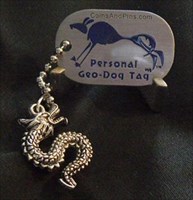This is no ordinary geocaching trading item!
*Missing* Serpent is a Personal Geo-Dog Tag Geocoin Travel Bug, traveling from geocache to geocache on a very specific mission.
 If you do not intend to log your visit on the Geocaching.com web site, please DO NOT TAKE THIS ITEM. Its travels and its progress requires you to log that it is being taken from this geocache. You will also need to log when you place it in another geocache. It's easy!
If you do not intend to log your visit on the Geocaching.com web site, please DO NOT TAKE THIS ITEM. Its travels and its progress requires you to log that it is being taken from this geocache. You will also need to log when you place it in another geocache. It's easy!
If you are willing to log your part of this Trackable's journey and place it in another geocache as soon as possible (after you log your find), grab it from this geocache.
My Current Goal:
Serpent is a symmetric key block cipher which was a finalist in the Advanced Encryption Standard (AES) contest, where it came second to Rijndael. Serpent was designed by Ross Anderson, Eli Biham, and Lars Knudsen.
Like other AES submissions, Serpent has a block size of 128 bits and supports a key size of 128, 192 or 256 bits. The cipher is a 32-round substitution-permutation network operating on a block of four 32-bit words. Each round applies one of eight 4-bit to 4-bitS-boxes 32 times in parallel. Serpent was designed so that all operations can be executed in parallel, using 32 1-bit slices. This maximizes parallelism, but also allows use of the extensive cryptanalysis work performed on DES.
Serpent was widely viewed as taking a more conservative approach to security than the other AES finalists, opting for a larger security margin: the designers deemed 16 rounds to be sufficient against known types of attack, but specified 32 rounds as insurance against future discoveries in cryptanalysis.
The Serpent cipher is in the public domain and has not been patented. There are no restrictions or encumbrances whatsoever regarding its use. As a result, anyone is free to incorporate Serpent in their software (or hardware implementations) without paying license fees.